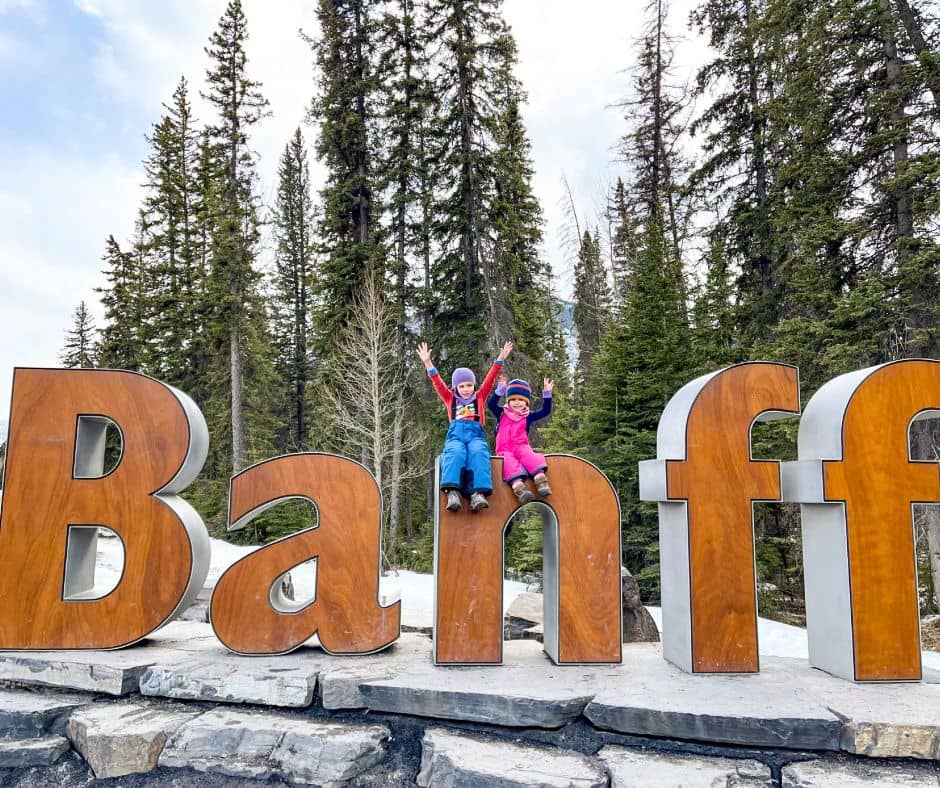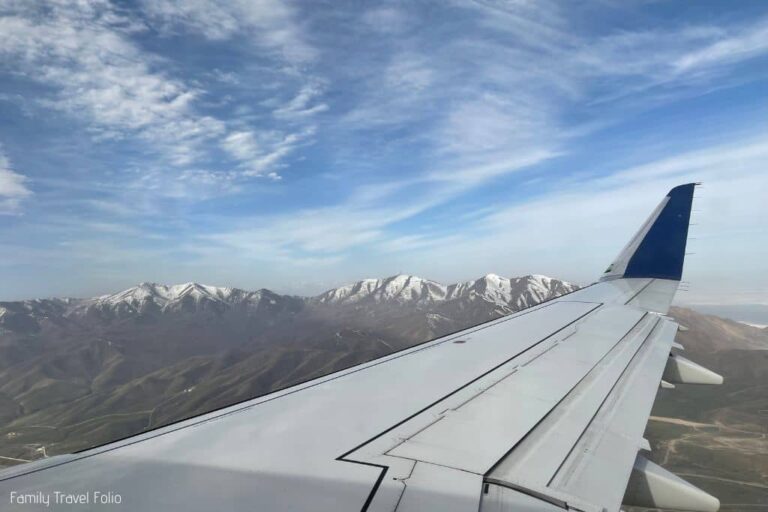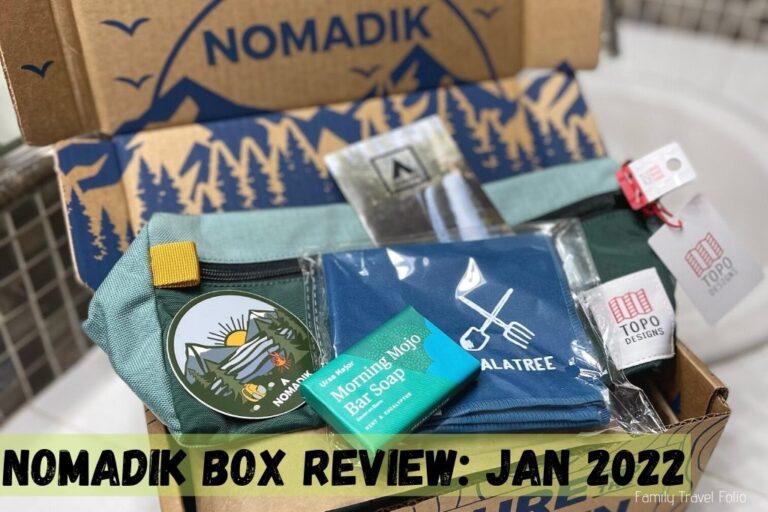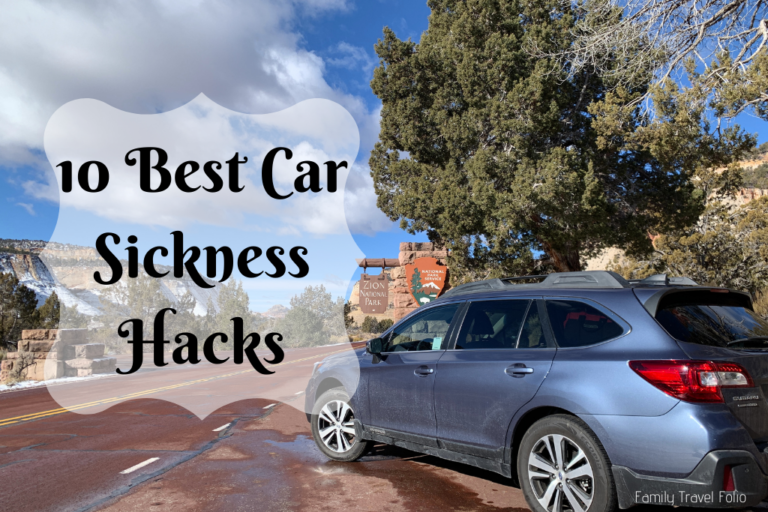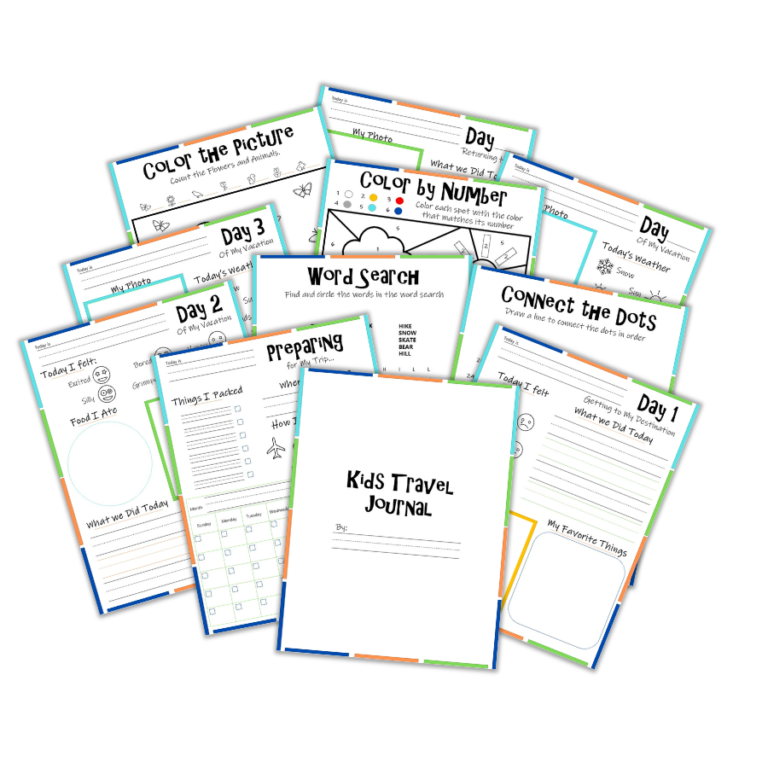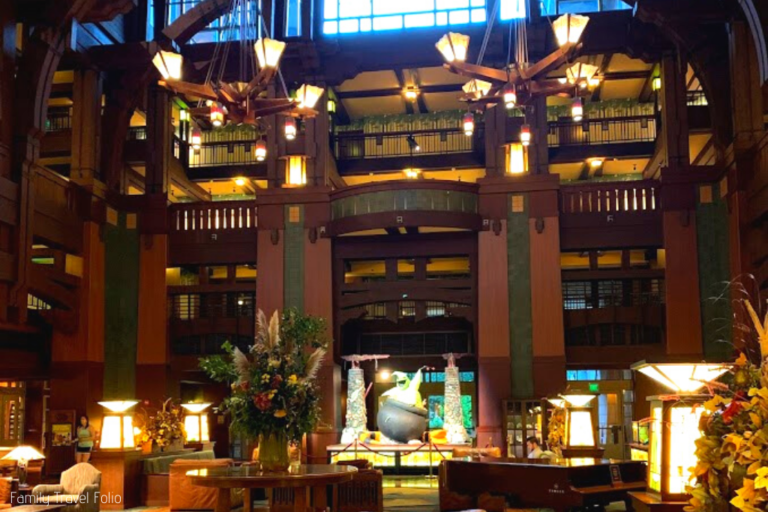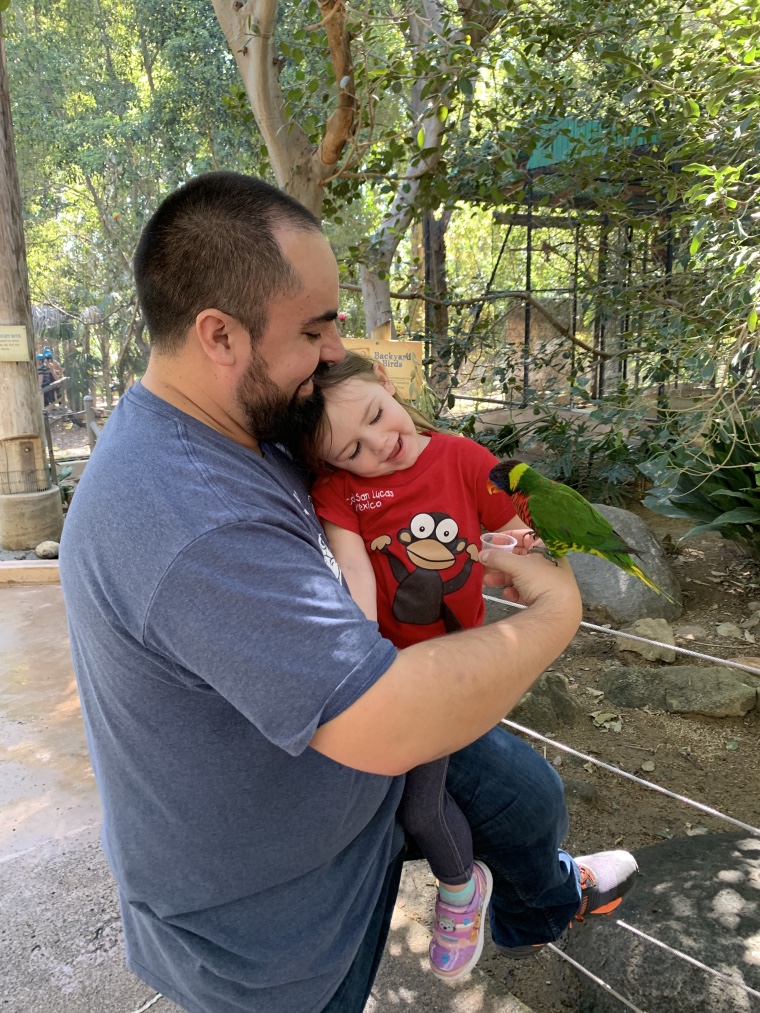Best Hiking in Banff: Top 10 Winter Trails
Banff National Park is in Alberta Canada and should be added to your top list of places to visit if you haven’t been already. In fact, it immediately turned into one of our favorite family vacation destinations.
There is so much to do and see in and around Banff National Park such as natural hot springs, historical sites, dog sledding, and more.
The best part though? The hiking trails in Banff and nearby Canmore.
Even in April, you get the most out of a winter wonderland of snow and ice, frozen waterfalls, and winter fun.
These 10 trails are ones we were able to do on a 9-day vacation with a toddler and a 5-year-old.
If you are traveling with kids, be sure to check out our tips for flying, avoiding tantrums, and our car sickness hacks.
Best Hiking in Banff and Canmore: 10 Amazing Family Winter Trails

1. Policeman’s Creek Boardwalk Trail
Difficulty: Easy Length: 2.6 Miles Elevation: 265 Ft Trail Type: Out & Back Notes: Kid friendly
Easy, flat trail alongside downtown Canmore. The trail follows a stream through trees with some bridges throughout.
One side of the trail does have the stream on the left with people’s houses to the right, but there are so many connections to other walking trails you really do get a good feeling of being surrounded by nature.
Lots of benches to sit and soak in the peaceful surroundings.
Our toddler fell asleep so I carried her for half the hike (we don’t bring the hiking carrier when it’s a flat trail she can walk), so the benches were very welcome.
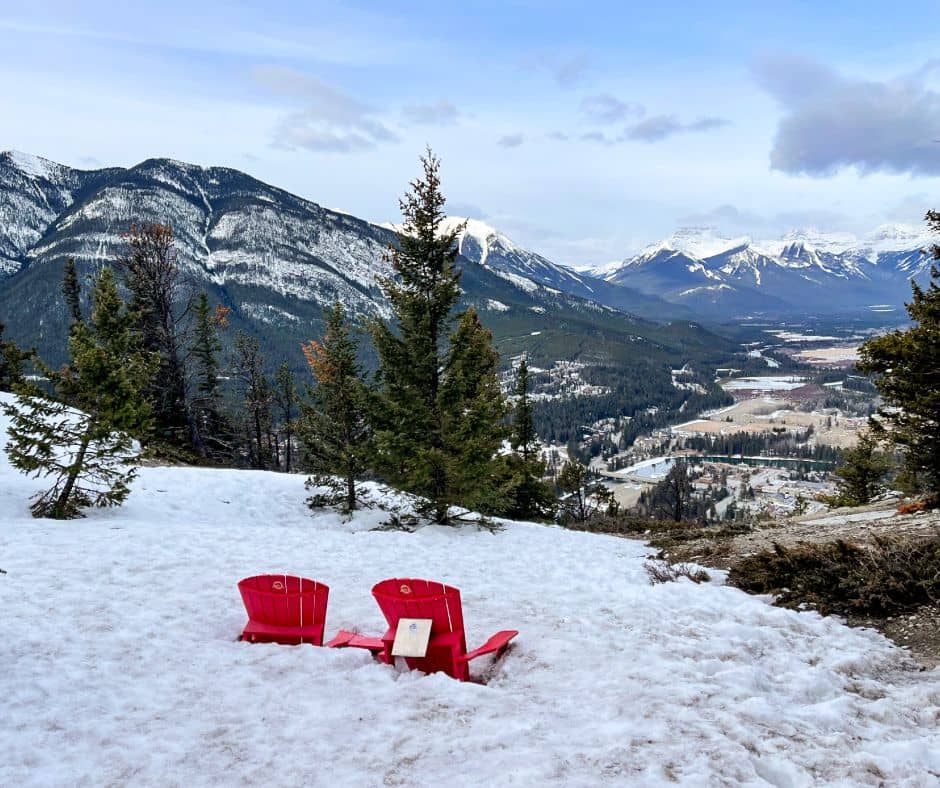
2. Tunnel Mountain Summit
Difficulty: Moderate Length: 2.8 Miles Elevation: 875 Ft Trail Type: Out & Back Notes: Kid friendly,but it does get a little steep at parts. May need crampons in winter conditions
This was our first moderate hike in Banff National Park.
Just challenging enough and long enough to be a good workout, but not so crazy that you’re completely wiped at the end.
On the way up we saw 2 deer which completely made my day.
It’s always exciting to find animals on hikes (from a safe distance of course).
The further up we went the icier the trail got.
We broke out our crampons which made the last bit of the ascent much easier. There may have been a couple of slips and falls before that…
So many amazing views. The best view, of course, was at the top where there are 2 red chairs.
Banff National Park has 11 red Chairs at their most scenic locations, and this was no exception.
Red chairs, deer. Steep but not too difficult. Very icy.
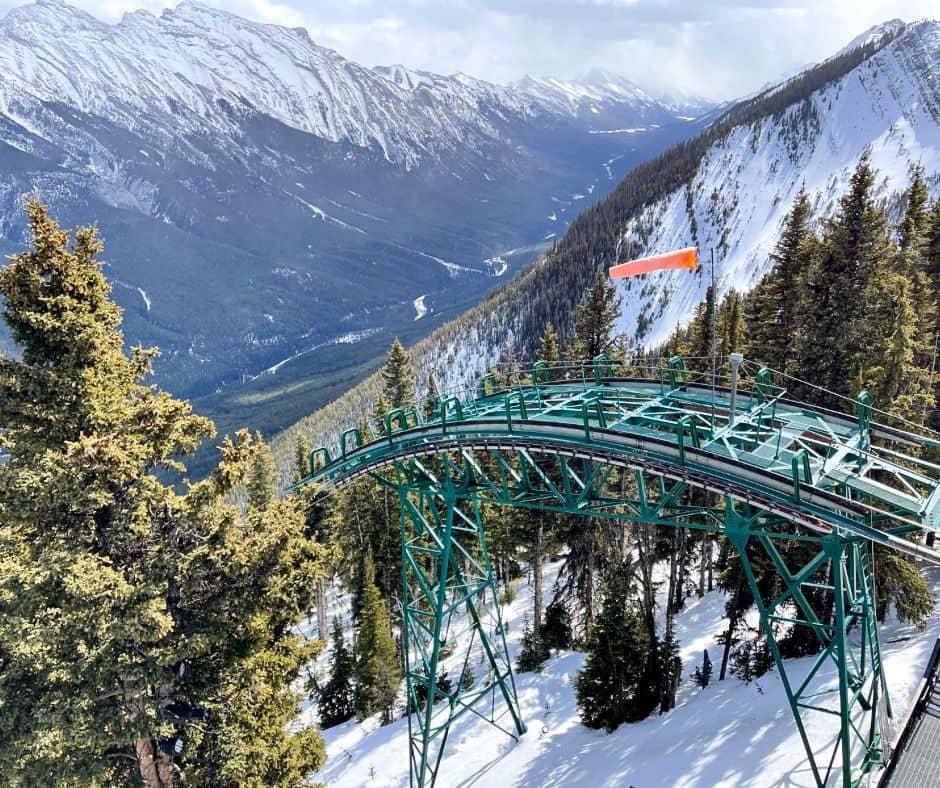
3. Sulphur Mountain Trail
Difficulty: Hard Length: 6.8 Miles Elevation: 2,480 Ft Trail Type: Out & Back Notes: Very steep trail, can also take Gondola to walk along boardwalk at top for amazing views
You can hike up the side of this mountain for an excellent workout, or take the Gondola ride up and just walk the boardwalk at the top for amazing views!
Easy, & family-friendly, the trail takes you to the Sulphur Mountain Cosmic Ray Station then back to the Gondola or hike down.
Plus they have a kid’s activity book for inside the Banff Gondola building. If your kids like activity books then definitely also check out our Kids Travel Journal for a fun memory to make while you travel.
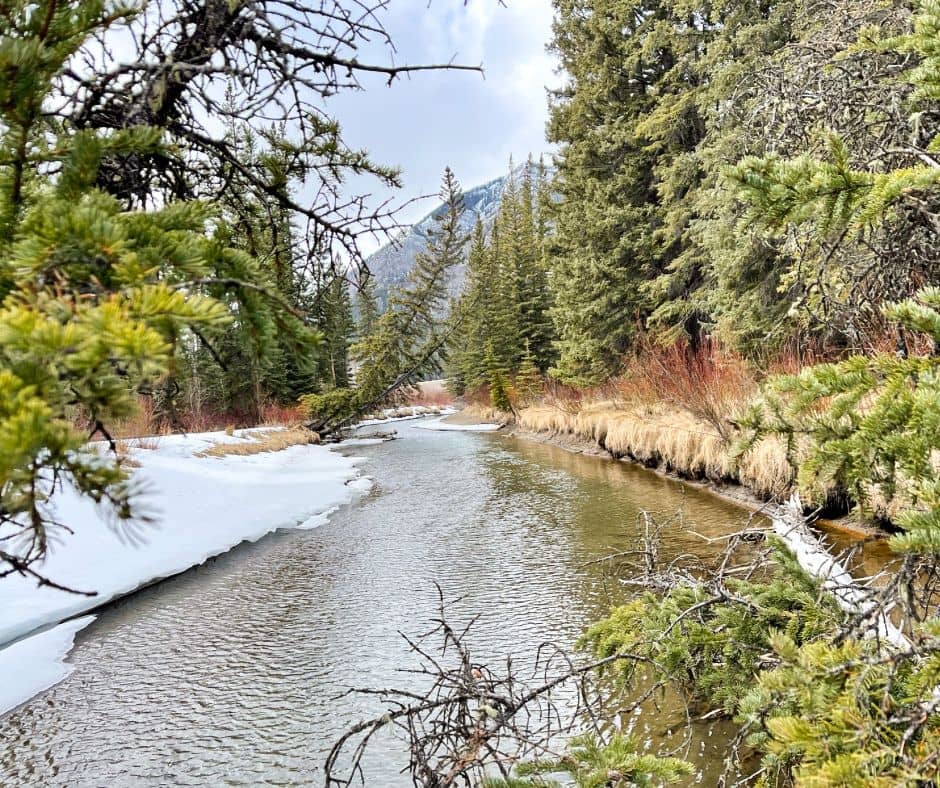
4. Fenland Trail
Difficulty: Easy Length: 1.1 Miles Elevation: 180 Ft Trail Type: Loop Notes: Kid friendly
Fenland Trail is similar to Policeman’s Creek Boardwalk Trail in that it is close to town, flat trail.
I think Fenland deserves its own spotlight though because this trail had beautiful views along a small river.
We even saw a beaver dam (although no sign of the beaver…).
Benches allow you to take in the view before continuing your nature walk. This was especially welcome because my toddler had fallen asleep and we did not have the hiking carrier with us.
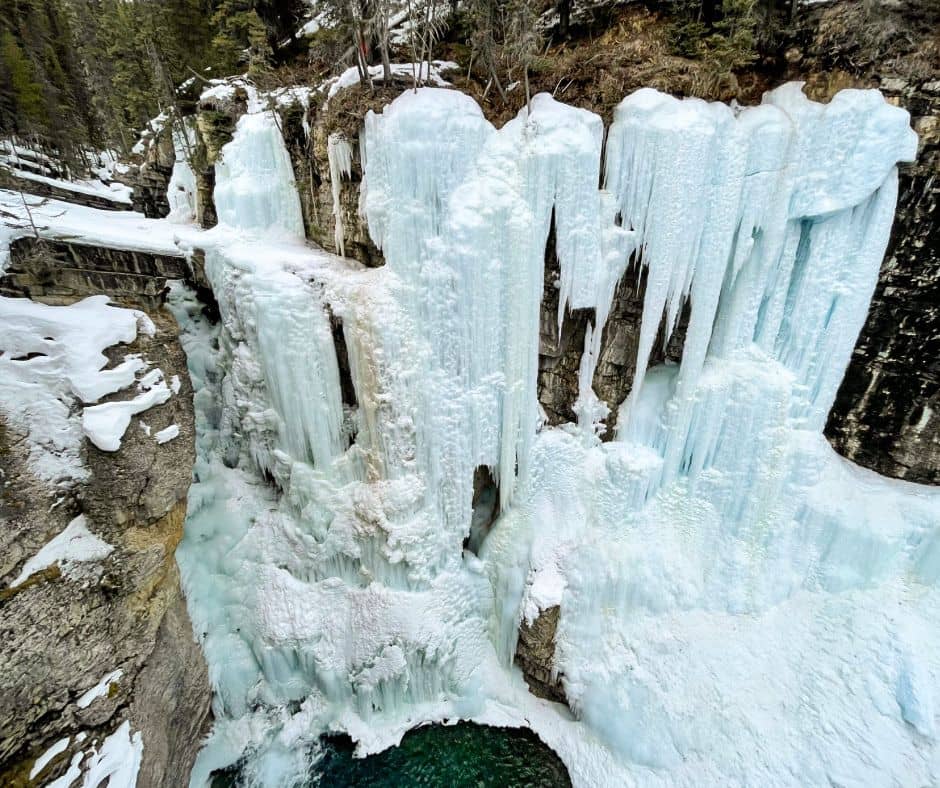
5. Johnston Canyon to Upper Falls
Difficulty: Moderate Length: 3.2 Miles Elevation: 859 Ft Trail Type: Out & Back Notes: Kid friendly, crampons were needed in winter conditions
Johnston Canyon to Upper Falls is easily my favorite hike from the entire trip to Banff National Park.
I wanted to see a frozen waterfall since I had never seen one in person before, and Johnston Falls did not disappoint.
The Johnston Canyon to Lower Falls was beautiful, but the real reward was at the Upper Falls. Imagine a frozen icicle-like waterfall cascading into a deep blue pool at the bottom.
Stunning.
The Lower Falls were not to be missed. You can actually go down to the base, walking through a little cave tunnel to get to the Lower Falls viewpoint.
The trail is made up of multiple bridges along the river which was a cool experience in itself.
I would love to hike this trail in a different season and see how much the landscape changes when it’s no longer frozen and covered in a blanket of snow.
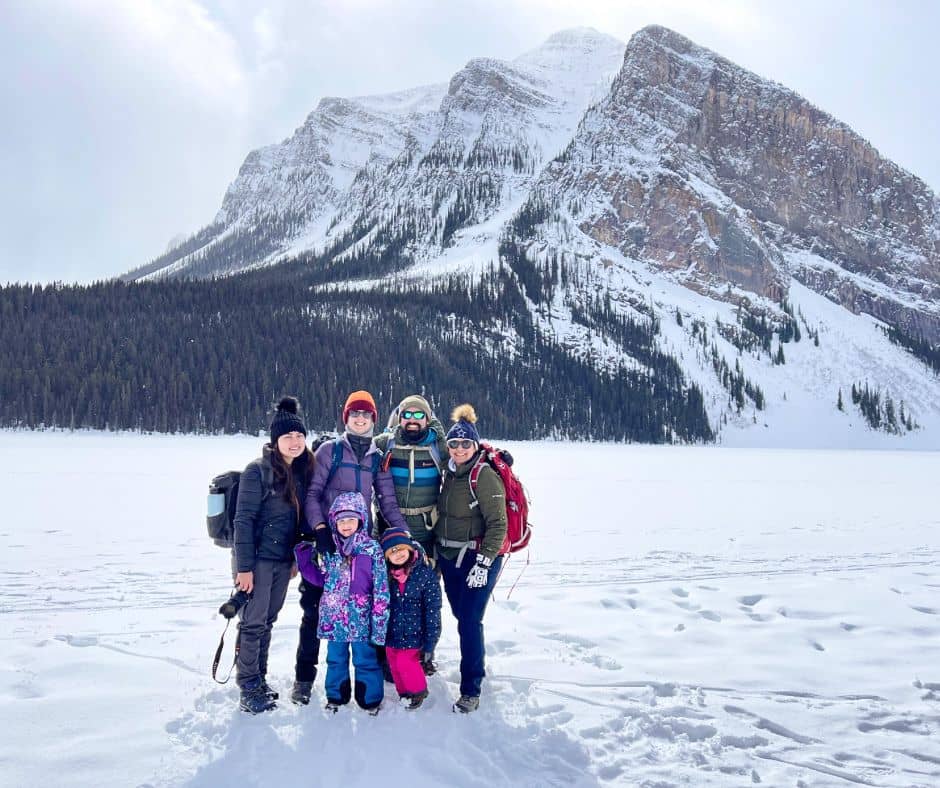
6. Lake Louise Lakefront Trail
Difficulty: Easy Length: 2.8 Miles Elevation: 354 Ft Trail Type: Out & Back Notes: Kid friendly
Lake Louise was a really fun stop along our Banff itinerary.
At first, I was a little bummed that the ice skating on the lake had closed for the season already. It was the beginning of April, and the ice was starting to thaw.
But there was still plenty of snow, a gorgeous frozen lake view, and hot chocolate readily available at the stunning Fairmont Chateau Lake Louise.
They still had horse-drawn sleigh rides and you could still walk out onto the lake (at your own risk). We started the Lake Louise Lakefront Trail along the edge of the ice and ended up stopping for an epic snowball fight.
The snow was the perfect sticky snowball snow!
As soon as we saw some thin ice, we turned around and went back. We didn’t want to risk falling through the ice into the lake. We probably would have been fine, but not being used to snow and frozen lakes, we didn’t think we were qualified to make a safe judgment call on continuing.
Instead of going to the trail next to the ice, we called it a day and checked out the inside of the Fairmont Chateau, including its cafe and gift shop.
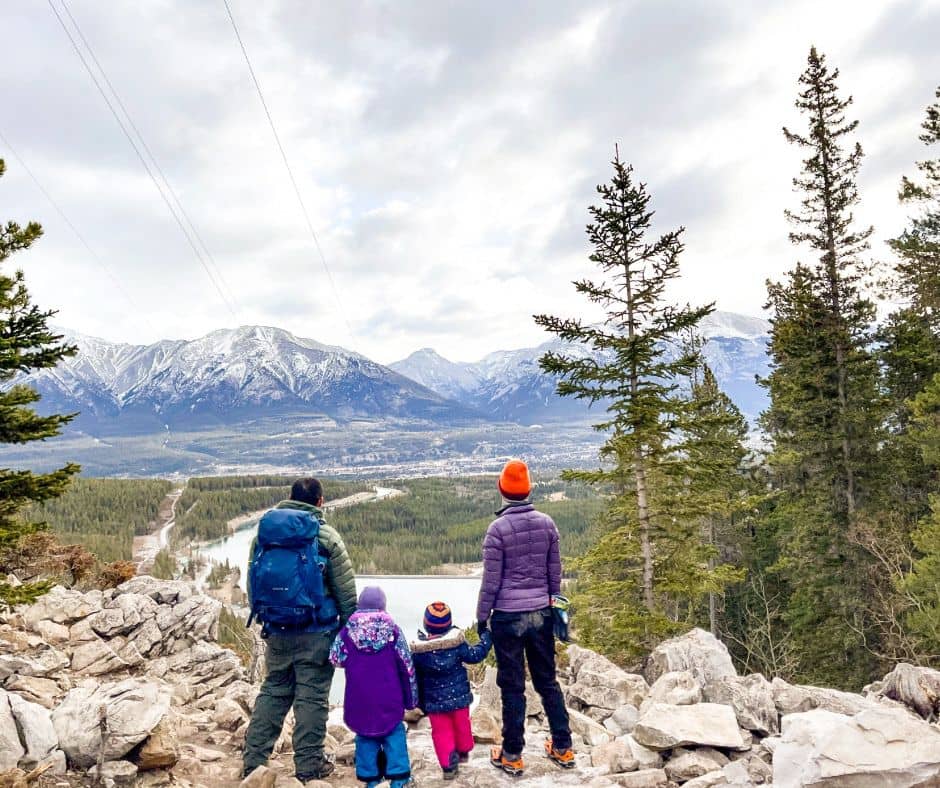
7. Grassi Lakes Trail
Difficulty: Moderate Length: 2.1 Miles Elevation: 583 Ft Trail Type: Loop Notes: Kid friendly, crampons were needed for most of the trail in winter conditions
We did this as an out & back hiking trail in Banff National Park since half the trail was closed. Absolutely amazing and worth the view.
There was a peaceful lake and waterfall at the top, with great views of the valley. I could have stayed here for the entire day.
Grassi Lakes is a great picnic destination. There are plenty of benches at the top (although no picnic tables) and beautiful scenery.
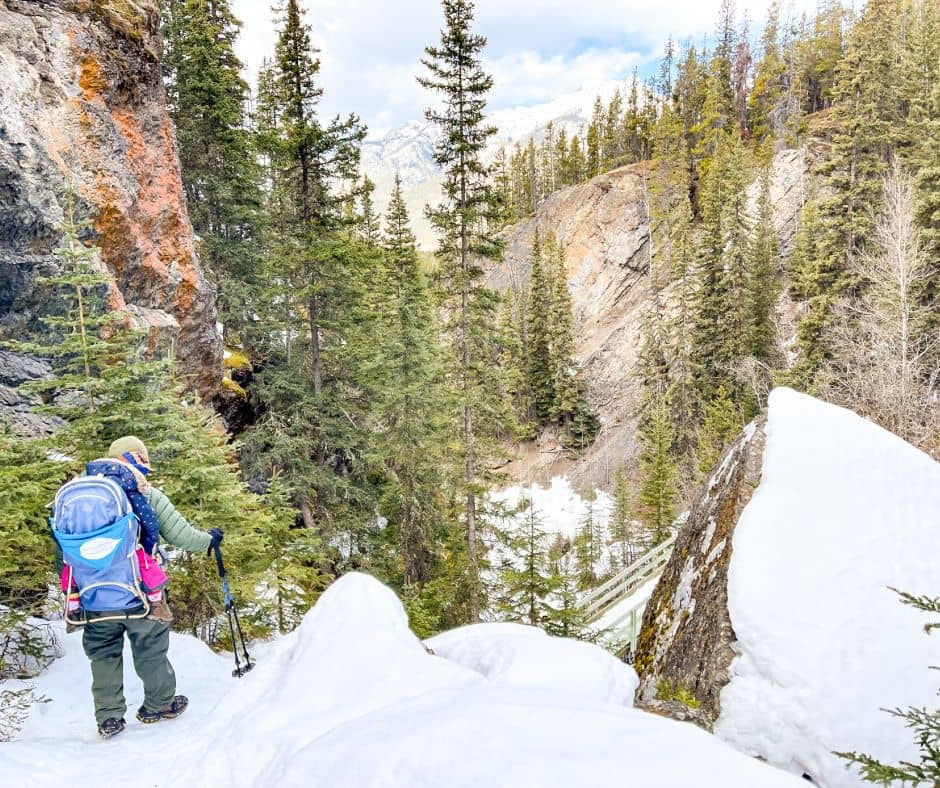
8. Sundance Canyon Trail
Difficulty: Moderate Length: 5.6 Miles Elevation: 1,151 Ft Trail Type: Out & Back Notes: Kid friendly, crampons were needed for most of the trail in winter conditions. A lot of the trail was covered in snow and ice, making it a more difficult hike even though it's listed as family friendly
Sundance Canyon Trail starts out simply as a flat trail along a river.
Once you start to climb, it gets a bit more intense, especially with the snow and ice. I found it very fun to climb up snow banks and walk along frozen bridges, but it may not be for everyone (especially beginner hikers) in this weather.
Also, there is no clear viewpoint. We never really reached “the top,” it keeps going to connect with other trails. Be sure to stop to turn and look on your way up so you can really appreciate the gorgeous view along the incline of the trail.
We went to the hot springs after this one which made for a very well-rounded and perfect day in Banff National Park.
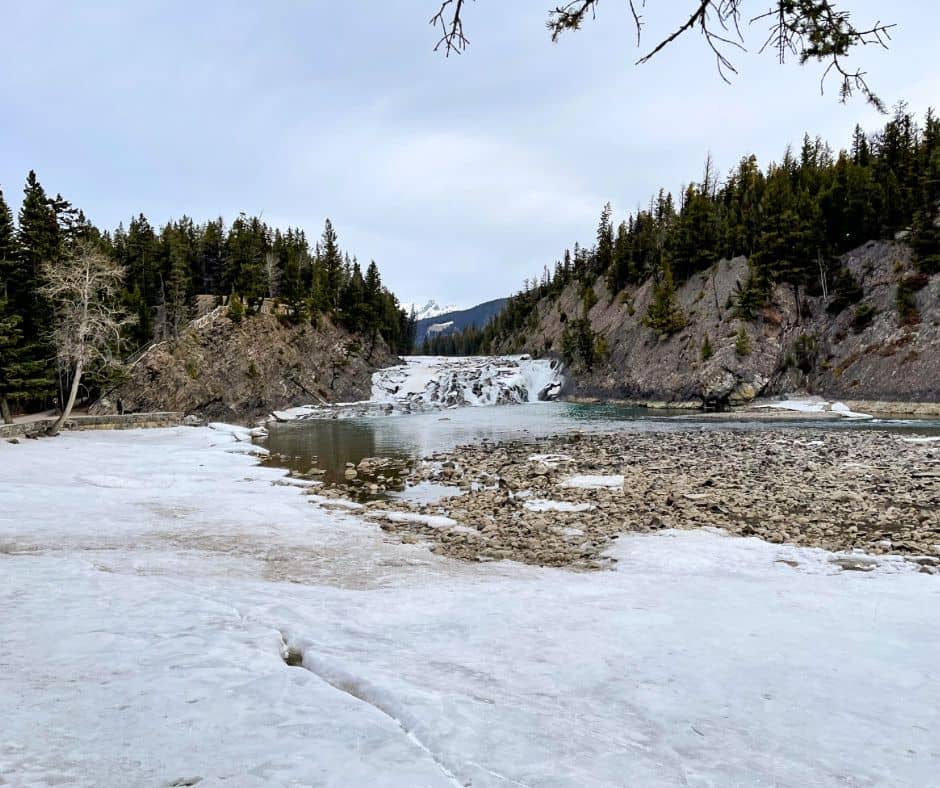
9. Bow Falls Viewpoint
Difficulty: Easy Length: 1.7 Miles Elevation: 216 Ft Trail Type: Out & Back Notes: Kid friendly
Bow Falls Viewpoint is the perfect trail for everyone. Just be careful on the steps if they have ice on them since those can get a bit slippery.
Otherwise, it’s a simple walk by the river. The end of the hike brings you to a beautiful waterfall and iconic scenery.
Bow Falls is fed by the Bow Glacier, but it is about an hour’s drive to get between the two.
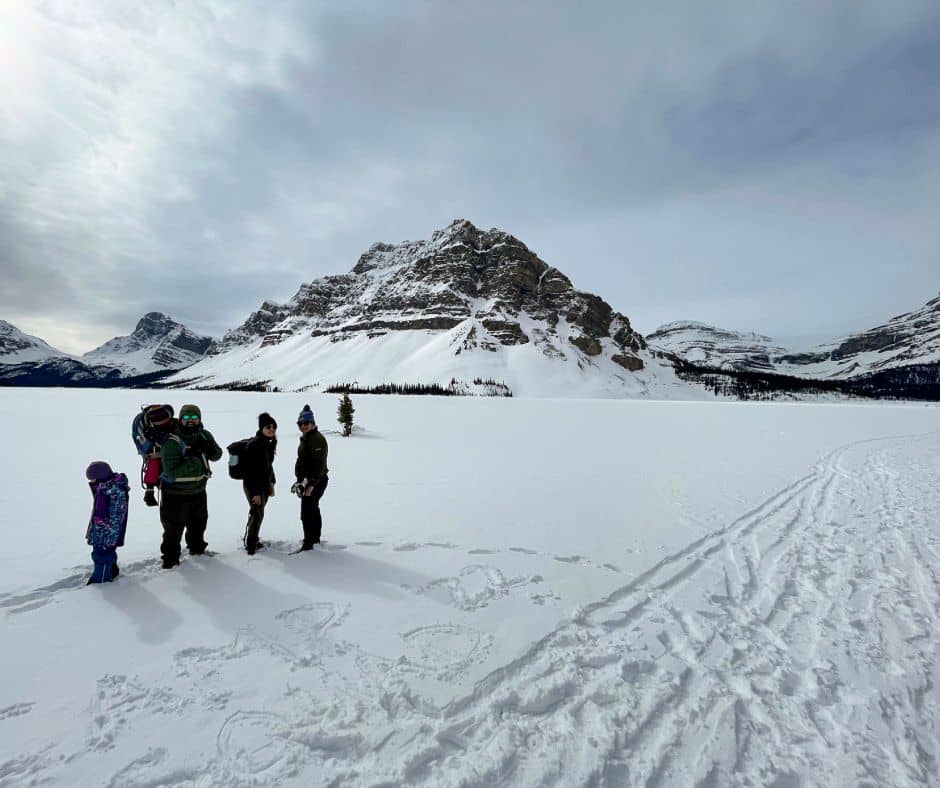
10. Bow Glacier Falls Trail
Difficulty: Moderate Length: 5.5 Miles Elevation: 977 Ft Trail Type: Out & Back Notes: Snow shoes needed in winter conditions
Snowshoes were a must for this hike, which we did not have. We walked until we started really sinking into the snow, then turned back around.
It was fun and silly, but only because we had the warm car very close by and did not venture very far. Make sure you always keep safety in mind, especially on trails in the winter.
The trek out to Bow Glacier was completely worth it! Even from a distance, you could see the glacier. Some of my favorite photos were taken on this hike.
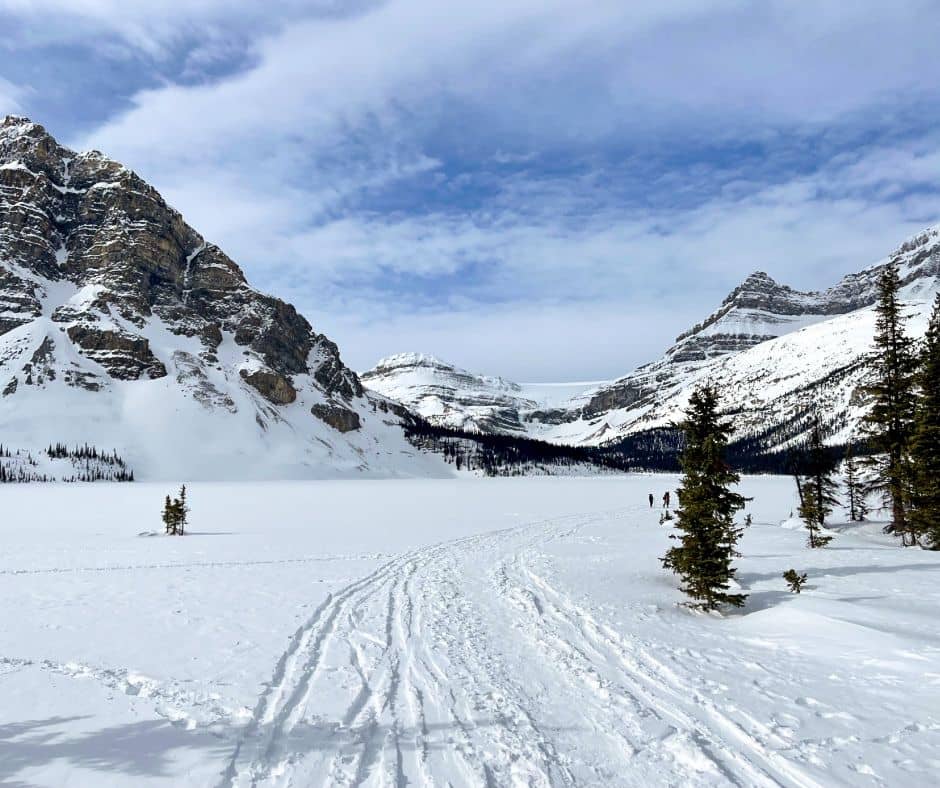
Gear to Hike Banff National Park in Winter & Early Spring
Clothing for Winter Hiking
Layer Your Clothing
Whenever you’re hiking in colder weather, layers are so important.
The first layer should be a base layer that dries quickly and is good at wicking the moisture off of your skin (i.e. you don’t get drenched with clothes soaked in your own sweat when you are literally in freezing weather).
Merino wool is great for this and makes for a very soft, comfortable, and functional base layer.
The middle layer should be something insulating to help keep you warm. If it’s really cold I’m wearing my base layer of long sleeves, my regular t-shirt, a down vest, and a down jacket.
The outer layer needs to be weatherproof so it helps as a windbreaker and water-resistant layer.
Of course, your typical accessories of gloves, hat, and warm socks with good weatherproof shoes are a must.
These same layers are also perfect for camping in the winter, so if you are going to try snow camping, check out more of our winter camping tips.
Balaclava Ski Mask
These were lifesavers. Wind and cold were no problem with these fleece ski masks.
We wore them to cover our ears and neck and lower face with our winter hats on top to help keep our heads warm and protected from the elements.
If it wasn’t super cold or windy requiring full head coverage, we could wear balaclavas around our necks to help keep us just warm enough.
Accessories for Winter Hiking
Crampons
Using Crampons or Ice Cleats is very important. Many of the trails were not just snow, but hard, slippery ice. Without Crampons, we would have been ice skating and falling all over the place.
Easy to put on and store in your hiking pack, take them with you on any hike that might have snow or ice.
Snowshoes are a bit different. They help you stay on top of the deep snow. These would have been useful for our hike at Bow Glacier but were not needed anywhere else.
Check the weather conditions first, ask the locals, and if you don’t want to risk turning around on a trail make sure you have them.
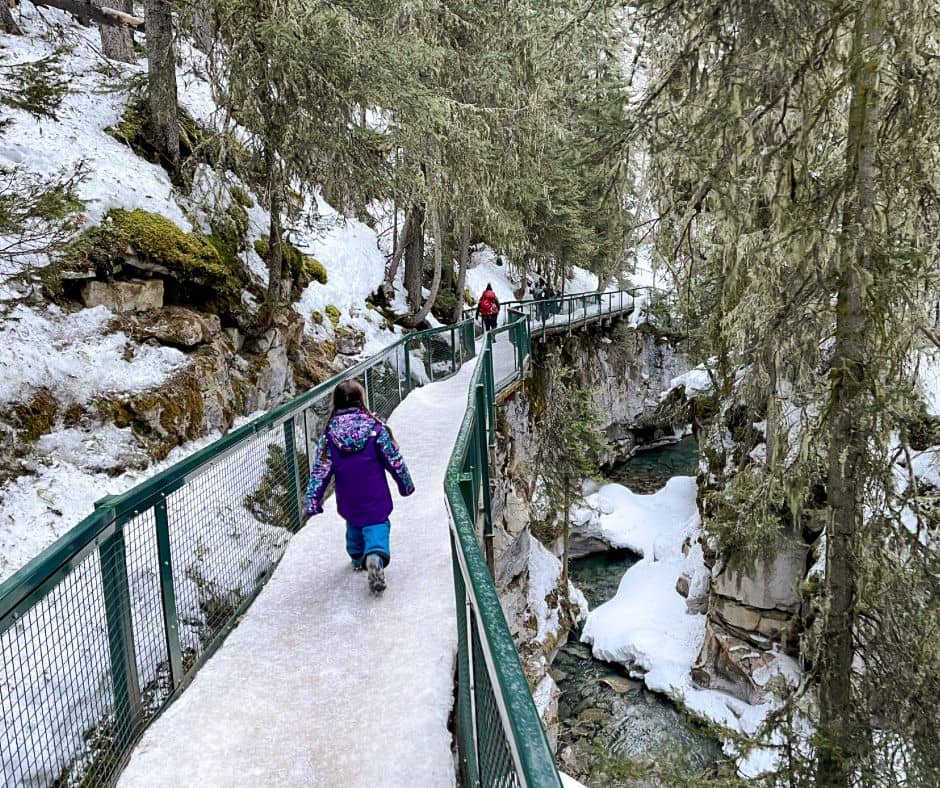
Hiking Poles
I usually don’t use hiking poles because I have a kid in one hand and a camera in the other, but they are so useful to help maintain your energy for longer and not put as much strain on your legs.
Even using just one pole can help with footing, balance, and distributing your energy efforts more evenly.
Sunglasses & Sunscreen
Snow is highly reflective. If you don’t have good UV ray protection on your eyes, your eyes can and will get sunburned.
Don’t forget to reapply the sunscreen: we forgot on some days and definitely felt the sunburn.
A good SPF chapstick is critical for sun protection and dry winter lips.
Water & Snacks
As with any hike, keep your energy up and stay hydrated.
It’s easy to forget to drink water when it’s cold outside. Try an electrolyte mix in your water to make it more fun.
We love trying out new flavors of Ultima Hydration Electrolyte Drink Mix. I’m not usually one to stress sugar-free (huge sweet tooth here), but for health reasons we needed to try something more balanced since we hike so often.
This is the only electrolyte water additive I have actually liked so far, and I am very picky.
Watermelon is our current favorite, but they have tons of flavor options.
Other Hiking Essentials
Make sure you pack for the 10 essentials which you can find in more detail in our checklist and essentials post.
It covers the basic gear of hiking and camping plus you can download our camping & hiking checklist for free.
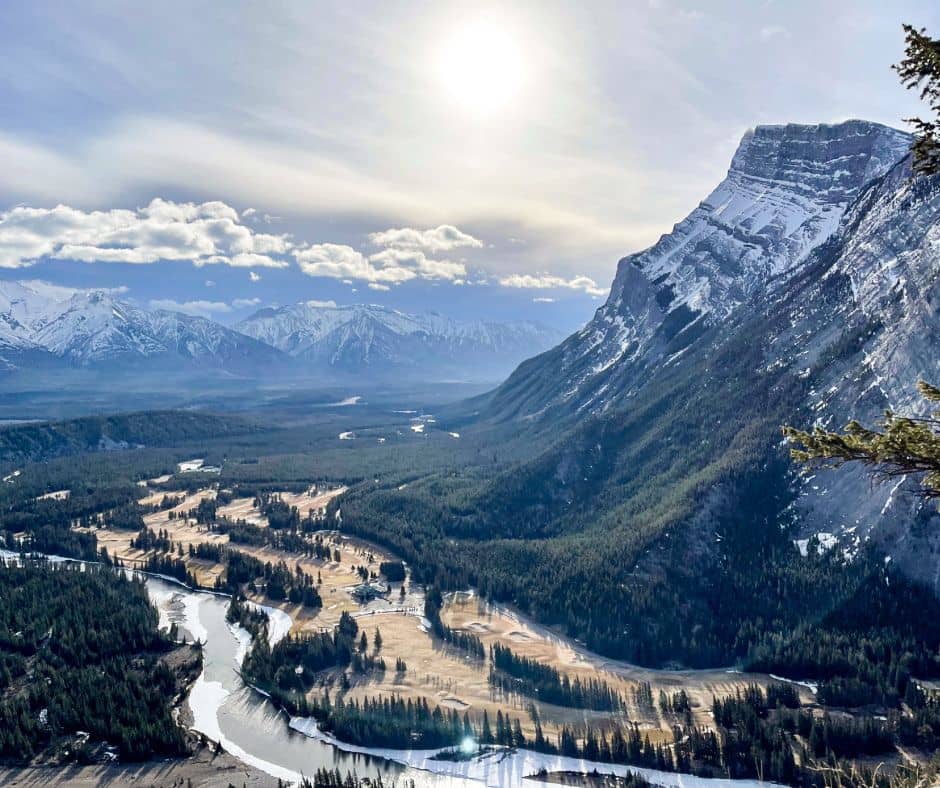
What is the Best Hike in Banff?
The best hike in Banff national park, in my humble opinion, is the Johnston Canyon to Upper Falls trail.
It had adventure, waterfalls, a decent incline, and some nice flat spots. The entire walk was beautiful and unique.
We did need crampons due to the icy conditions, and we couldn’t walk to the base of the upper falls due to the weather, but it was still my favorite hike. Snowflakes were gently falling on our way back to the car. It was perfect.
Sundance Canyon Trail would be better suited as the best hike in Banff if you are looking for a great workout. The climb itself wasn’t too strenuous, but part of the trail does get steep and it is longer at 5.6 miles.
A true challenge would be Sulfur Mountain Trail. It is almost 7 miles and has almost a 2500-foot elevation gain.
This should be regarded as the best hike in Banff because it has a challenging option as well as a Gondola ride to the upper boardwalk portion for those who can’t quite make that climb. Both options are rewarded with amazing views.
If you want the best iconic red chair hike in Banff National park, I would say go hike Tunnel Mountain Summit. Another moderate hiking trail in Baff that is just shy of 3 miles long with decent but not impossible elevation gain.
Out of the red chairs we found, I liked the ones at the Tunnel Mountain Summit the best for their view. Even though they were covered in ice…
Whatever trail you choose, the best hike in Banff for you will match your own hiking speed.
Figure out what Distance, Elevation, and Weather you are comfortable with and make your choice from there.
Be sure to check out our tips on hiking with kids, and our post with a few additional winter hiking tips.
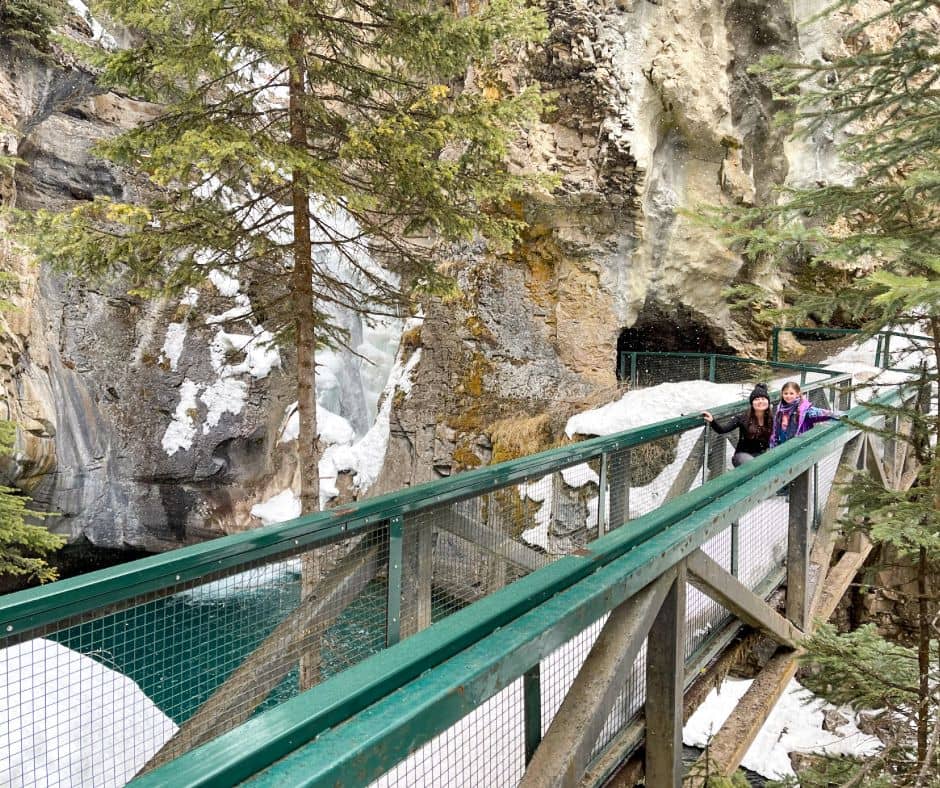
FAQ
Hiking in Banff National Park can be as easy or difficult as you want it to be. There are flat trails and more challenging ones all offering a unique view of the beautiful landscape.
Yes, you can absolutely hike in Banff in April. There will likely be a lot of snow still if you go in early April, so it will feel like winter. Some trails or parts of trails may be closed due to weather, but there are amazing views and hikes available in April in Banff National Park.
In my opinion, if you want to explore Banff in winter April is a great time to go! The weather can be snowy and cold, but not as drastic of temperatures as in the middle of winter.
The best hike in Banff is the Johnston Canyon to Upper Falls Trail. If you can’t do a challenging hike, you can always stop at the lower falls, then turn around. In winter, you are rewarded with gorgeous frozen waterfalls. It really is a winter wonderland.
April is a good time to visit Lake Louise, but there may not be as many activities out on the lake. The ice from winter will be starting to melt. When we went at the beginning of April, they had already stopped ice skating for the season. Still, it was absolutely gorgeous and worth visiting.

